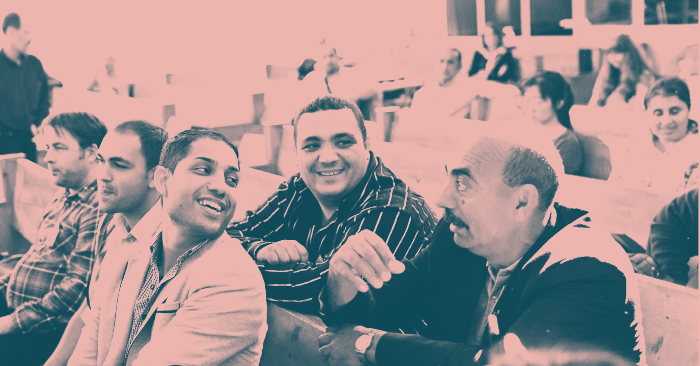Movements in Mission
Christianity Among the Roma (Gypsies)

Although 'Gypsy' may be a more recognizable name, it can also convey a derogatory meaning in some European contexts. Therefore, in general, we use the term 'Roma' in this issue, apart from historical usage or a group who specifically refer to themselves as Gypsy.
Recently, I had the privilege of attending a Romani friend’s wedding. Tables laden with food, a brass band playing music for hundreds of people dancing for hours—this was a rich experience of sights, sounds, and tastes like nothing I had ever experienced. More than that, however, it was also an example of uninhibited celebration, expression of joy in dance, and an extravagant hospitality—all were welcome to the party. Suddenly, I had a tangible picture of God’s lavish generosity—a God who welcomes and even seeks the uninvited guests, a God who throws a feast to welcome prodigals home, and a God who “rejoices over us with shouts of joy”(Zephaniah 3:17).
Over the last six years, as I traveled throughout Eastern Europe forming relationships and learning about the Roma in numerous contexts, I experienced many transformative moments. My understanding of God expanded, my conception of His mission shifted, and certain elements of Roma culture and Roma Christianity deeply challenged me. In Eastern Europe, where many Roma communities remain marginalized from the majority society, I have also been burdened and grieved by seeing the cyclic effects of deep poverty and hearing stories of trauma, rejection, and pain. Jesus Christ, as Christian Roma leaders assert, is the only hope; indeed many Roma testimonies manifest the truth of Ephesians 3:18,19–grasping the immensity, richness, and vastness of Christ’s love liberates and restores Roma identity. As a beloved son and daughter of God, being filled "to the measure of all the fullness of God" is the key that releases God’s power to transform, empower, and equip for mission.
Who Are the Roma?
To understand why this is such a profound witness to the power of the gospel, it is necessary to understand both the current situation of the Roma and the story of Roma Christianity. In Europe, historical accounts first noted the Roma in the 12th century. Although during the Middle Ages, their trades were often portrayed as a valuable contribution to societies, by the 16th century, various areas of Central and Eastern Europe were developing negative attitudes and policies toward them.[1] In the centuries that followed, ruling powers attempted to fit them into the constraints of society, through mechanisms including assimilation, forced sedenterization, slavery, and extermination during World War II. Despite a shift in state policies and increased international attention over the last couple of decades, particularly in Eastern Europe, many Roma communities are in a deeper state of poverty than the majority populations and, additionally , they faced discriminatory attitudes reinforcing their marginalization.

However, it is a mistake to think of the Roma as a monolithic group, and the use of different ethnonyms can lead to confusion for those unfamiliar with the heterogeneity of Roma group. For example, there are groups who identify as Roma, Romani, Gypsy, Gitano, Travellers and Sinti. Roma or Romani is used in this article in its broadest sense—to describe groups of people who may speak one of the Romani dialects, may have a shared experience and sense of history, cultural practices, and/or self-identify as Roma, Romani, or Gypsy.
It is also a mistake to think that all 10-12 million Roma in Europe are poor and marginalized. In fact, there are wealthy Roma groups and individuals, and there are Roma in every layer of society: academics, lawyers, musicians, actors, and politicians. There are Roma organizations, NGO’s, and political advocacy groups. There are also Roma churches and Christian movements that have their own Bible schools, training programs, and church praxis. Consequently, it is good practice to approach each community on its own terms, listening to how they self-identify and not making assumptions. “Who has the right to name us, to tell us who we are?” asked one Roma pastor at a 2016 Roma conference.
Christianity and the Roma
The Roma in Europe are Catholic, Orthodox, Protestant, Jehovah Witness, and Muslim. Often, the Christian Church’s attitude mirrored that of society, and there are accounts of the Church refusing baptism and confessions to Roma.[2] In fact, in the past, due to the lack of engagement in religious institutions, some scholars concluded that the Roma were "insincere" in their religious commitment, although current scholars have argued that this was a result of racist and exclusionary attitudes from the Church.[3] The insincerity hypothesis can also be challenged by what has been happening among the Roma for decades. That is, Protestant Christianity has been spreading through Roma communities in Europe, North and South America, and beyond.
One of the most prominent and well-documented catalytic locations of a “Gypsy Revival” began in France in the 1950's when a Manouche family experienced the healing of a family member. Clément Le Cossec, a minister in the Assemblies of God church and a non-Roma, devoted his life to encourage this “Gypsy Awakening” by equipping and training leaders and missionaries. For some this meant learning to read. The movement crossed over to different Roma groups and spread to numerous countries and continents.[4]
In Eastern Europe, the Baptists were active in Bulgaria in the early 20th century, and Pentecostalism began spreading in the 1940’s and 1950’s, with rapid expansion beginning both in Romania and Bulgaria after the fall of Communism. The most internationally well-known Roma revival in Romania took place in the town of Toflea, beginning in the 1990’s and peaking in 2003, with their largest baptism being around 500 people. Known as Rugul Aprins (Burning Bush), the members who migrated from Toflea for economic reasons started their own churches and the primary pastor reports 10 churches in Romania, 5 in England, 1 in Spain, and 1 in Germany.[5]
For many complex reasons, reliable numbers of Roma populations in Europe are hard to come by, and the same can be said for the number of Roma Christians. However, certain contexts have educated estimates. For example, the number of active Roma Christians is over 200,000 in Spain, over 140,000 in France, tens of thousands in Bulgaria and Romania, and thousands in places like Slovakia and Hungary.[6]
Just as Roma identity and context cannot be understood monolithically, so it is the same with Roma Christianity—more accurately viewed as movements with just as diverse praxis and theology as you might expect to find in churches of other nations or ethnicities. There are large, well-established Roma churches and small struggling churches and home groups. There are Roma churches with missional impulses stretching to the non-Roma, and other churches that focus just on their particular Roma group.

This issue's themed articles are meant to exhibit this heterogeneity. There are both Roma and non-Roma writers, each speaking from a different context and perspective. To help set the framework of the wider picture, these five themes emerge in the articles.
1. The Rapid Growth of Roma Pentecostalism
Roma Pentecostalism is the stream of Christianity growing most rapidly. At its present conversion rates, some scholars suggest that it will be the prime form of Roma religiosity in a few years.[7] At least in Eastern Europe, it is common to hear testimony of coming to Christ through miracles, healings, dreams and visions. Some Roma leaders have a sense that the Roma will be key to evangelizing other nations within Europe–that they will bless other nations.
2. Towards Holistic Transformation
Many Roma communities face deep poverty and marginalization from the majority culture, therefore there is an acute need to both understand the complexity of factors which contribute to this and an orientation towards holistic development based on the Roma leaders’ perspective of what needs to change.
The Roma communities in Croatia in which I serve are certainly not the poorest I have seen, but even so, the issues of a marginalized minority community in a country already facing socio-economic hardship are acute and complicated. One day, I accompanied a woman from my community who was attempting to apply for health insurance. In the space of a few hours, we visited 6 different offices. This woman cannot read, and I marveled at her adeptness at navigating a system based on the ability to read. At the same time, I also got a sense of the vulnerability one faces. In our church community, over half the adults in church are functionally illiterate. Many children drop out of school before finishing eighth grade. All have continual health issues. Most survive on social help and temporary seasonal labor such as street cleaning. Not all have electricity or running water.
3. Training and Equipping
With the rapid growth of Roma Christianity, there is an acute need for training and equipping of Roma leaders. Although certainly there are Roma leaders attending Bible schools and universities, as well as some movements which have their own autonomous Bible schools, Roma leaders still express the need for more tools and training.
In the past, and even now, other churches or missionaries have not deemed the Roma “capable” to lead their own churches. The Gypsy And Traveller International Evangelical Fellowship (G.A.T.I.E.F.), which grew out of the Gypsy revival in France, has been highly successful in mentoring, training, and sending numerous Roma pastors and missionaries. They are active in 24 countries in several continents. The current leader, René Zanellato wrote in his 2014 update regarding the “secret” to this success:
The error has been that certain leaders of churches and organizations did not understand and did not trust the work and the capacity of the Holy Spirit to let the Gypsies themselves evangelize the Gypsies. These countries and pastors have been a hindering to the development and to the Revival, wanting to impose to the Gypsies their rules and their non-Gypsy mentality.[8] [sic]
4. Lack of Trust as a Missional Barrier
Attitudes of prejudice or stereotyping, based on longstanding, ingrained images of the Roma, are prominent in the majority populations. However, prejudice can also exist between different Roma groups and from the Roma to the non-Roma (gadje). I have argued elsewhere that reconciliation must be a key structure of mission and is critical for the holistic transformation of communities.[9] Transformation can only progress so far if relationships between Roma and non-Roma are not healed and renewed.
5. The narrative matters...and this relates to mission praxis
How we tell stories is critical for shaping attitudes and actions toward Roma communities. Even as “mission popularity” rises iregarding the Roma, I have become increasingly aware of the images and language used to depict the Roma. This would be a fabulous theme for a future issue on a broader scale--how we, as an evangelizing church, often present a foreign culture/people in our biases, in order to show an evangelism which can be derogatory.
Listening, learning, and asking as an orienting practice for mission are not new insights in 21st century missiology. And yet all too often our mission praxis continues to repeat mistakes made in mission history. As we participate in God’s mission, we must constantly be open to the critique of our motives, strategies, and perspectives. As Father Greg Boyle concludes: “I discovered that you do not go to the margins to rescue anyone. But if we go there, everyone finds rescue.”[10]
[1] Crowe, David. A History of the Gypsies of Eastern Europe and Russia. (New York: Palgrave Macmillan, 2007), xvii, xviii.
[2] Atanasov, Miroslav. “Gypsy Pentecostals: The Growth of the Pentecostal Movement Among the Roma in Bulgaria and Its Revitalization of Their Communities.” (Asbury Theological Seminary, 2008). p. 99-101
[3] Acton, Thomas A. “New Religious Movements among Roma, Gypsies and Travellers: Placing Romani Pentecostalism in an Historical and Social Context.” In Thurfjell & Marsh eds. Romani Pentecostalism, (Frankfurt: Peter Lang, 2014), 27,28
[4] Laurent, Régis. “On the Genesis of Gypsy Pentecostalism in Brittany.” In Thurfjell & Marsh, eds. Romani Pentecostalism, 33, 39.
[5] Information accumulated through interviews by author in person with Anuşa Capitanu (Toflea, Romania, July 2015), Ilia Bolmandor (Bucharest, Romania, July 2015), and Ioan Caba (Oradea, Romania, July 2015).
[6] Cantón-Delgado, Manuela. “Gypsy Leadership, Cohesion and Social Memory in the Evangelical Church of Philadelphia.” Social Compass (2017), 5; Gypsy and Traveller International Evangelical Fellowship 2014 Report, Rene Zanellato; Slavkova, Magdalena. “Prestige” and Identity Construction Amongst Pentecostal Gypsies in Bulgaria.” InThurfjell & Marsh eds. Romani Pentecostalism; Podolinska, Tatiana, and Tomaš Hrustič. “Religion as a Path to Change? The Possibilities of Social Inclusion of the Roma in Slovakia.” (Friedrich Ebert Stiftung, 2010.)
[7] Thurfjell, David, and Adrian Marsh, eds. Romani Pentecostalism, 8.
[8] G.A.T.I.E.F 2014 Report, Rene Zanellato, [email protected]
[9] Wachsmuth, Melody J. “Roma Christianity in Central and Eastern Europe: Challenges, Opportunities for Mission, Modes of Significance.” In Mission in Central and Eastern Europe: Realities, Perspectives, Trends (Oxford: Regnum, 2017),
[10] Boyle, Greg. “I thought I could save gang members.” The Jesuit Review, March 2017. http://www.americamagazine.org/faith/2017/03/28/father-greg-boyle-i-thought-i-could-save-gang-members-i-was-wrong









comments